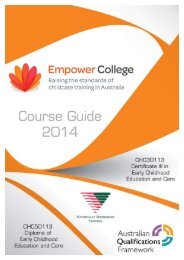Anaphylaxis Management Guidelines
You also want an ePaper? Increase the reach of your titles
YUMPU automatically turns print PDFs into web optimized ePapers that Google loves.
It is appreciated that some child care services do not have any children<br />
who have been diagnosed as being at risk of anaphylaxis. Despite this,<br />
licensees of child care services are advised that they should ensure that<br />
members of staff, who are responsible for first aid, have the knowledge<br />
and skills to respond to an anaphylaxis emergency.<br />
Parents/guardians<br />
of children at risk<br />
of anaphylaxis<br />
Parents/guardians who have a child at risk of<br />
anaphylaxis are encouraged to assist child care<br />
services in providing a safe environment for<br />
their child.<br />
Parents/guardians should:<br />
Inform the licensee or supervising officer of<br />
the child care service of their child’s allergies<br />
and whether a diagnosis has been made as<br />
to the risk of anaphylaxis (e.g. provide an<br />
ASCIA Action Plan completed by their child’s<br />
medical practitioner). This advice should<br />
be provided either at enrolment or when a<br />
diagnosis has been made.<br />
Meet with the child care staff to develop<br />
their child’s Individual <strong>Anaphylaxis</strong> Health<br />
Care Plan (see Appendix 3). This plan<br />
should include an ASCIA Action Plan (see<br />
Appendix 7) completed by their child’s<br />
medical practitioner.<br />
Participate in annual reviews of their child’s<br />
Individual <strong>Anaphylaxis</strong> Health Care Plan.<br />
Inform child care staff of all other relevant<br />
information and concerns relating to the<br />
health of their child.<br />
Provide the adrenaline autoinjector and any<br />
other medications to the service.<br />
Replace the adrenaline autoinjector and<br />
any other medications before the expiry<br />
date. It may be advisable to check expiry<br />
dates quarterly.<br />
Alert staff to the additional risks associated<br />
with non-routine events and assist in<br />
planning and preparation for the child prior<br />
to field trips, child care service activities,<br />
excursions or special events.<br />
Discuss the supply of alternative food<br />
options for their child when needed.<br />
Inform staff of any changes to their child’s<br />
emergency contact details.<br />
Provide the licensee or supervising officer<br />
with an immediate update if there is a<br />
change to their child’s condition.<br />
Educate their child about only eating<br />
food provided from home. It is important<br />
to reinforce that their child should not<br />
share food.<br />
Licensee/Supervising<br />
Officer<br />
Licensees have an overall responsibility for<br />
strategies and processes for ensuring a safe<br />
and supportive environment for a child at risk<br />
of anaphylaxis. The Supervising Officer is<br />
responsible for implementing those strategies<br />
and processes. In the case of a Family Day<br />
Care service, these roles are combined,<br />
however the Family Day Care service provider<br />
may seek the support of their Family Day<br />
Care scheme.





